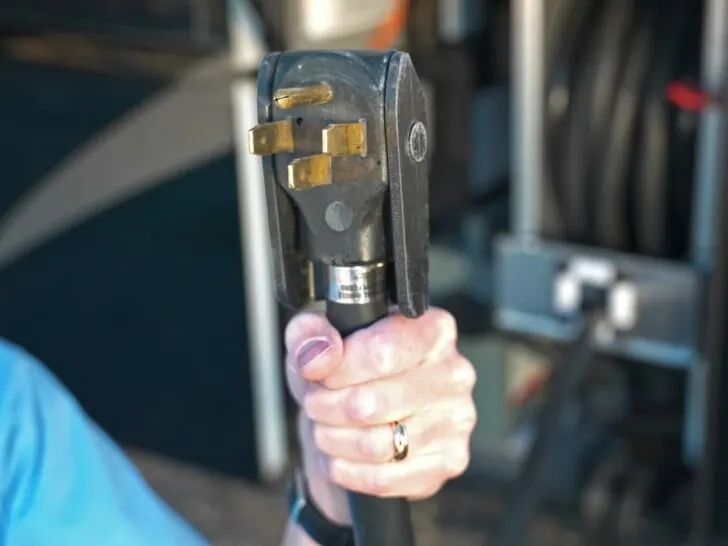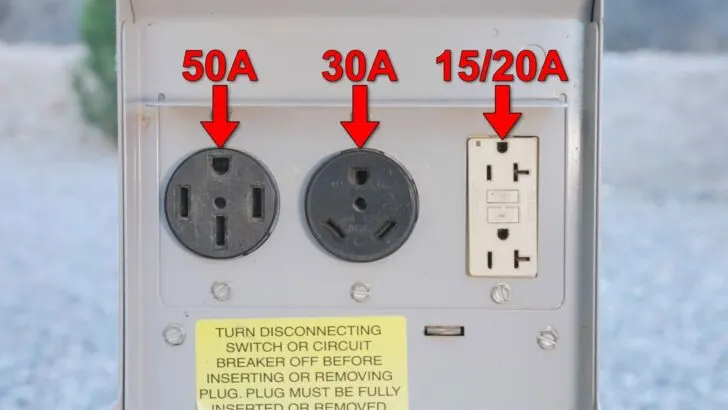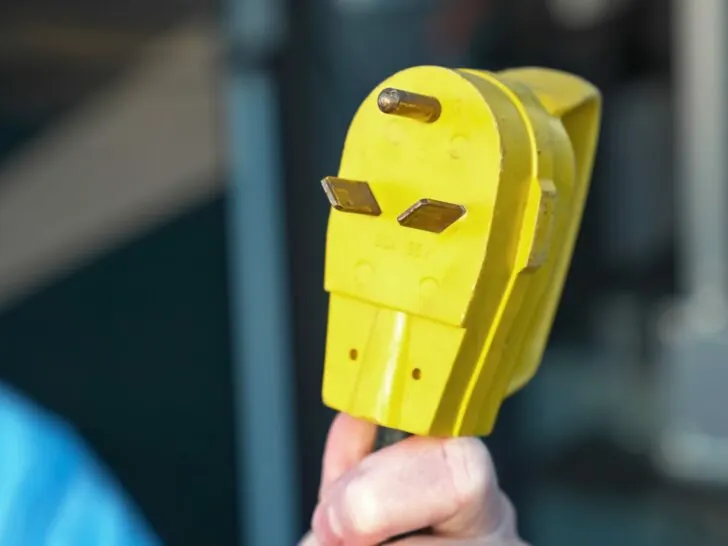The 50 amp RV plug is a powerful thing! In fact, it has the capacity to power everything in your RV no matter what size rig you’ve got.
People often wonder how much a single 50-amp plug can really handle. Well, we can power our entire motorhome on a 50-amp plug when we’re connected to shore power.
For nearly two decades now, we’ve lived, worked, and traveled full-time in a 43’ diesel pusher with two air conditioning units, a washer & dryer, a residential refrigerator, and a host of other appliances along with a LOT of technology.
We’re here to tell you that the 50-amp RV plug can power it all, and then some.
In this post, we’ll investigate the 50-amp RV plug to explain and demonstrate what it looks like, how it works, and why it’s so powerful.
What Is a 50-Amp RV Plug?
In short, a 50-amp RV plug is a four-pronged power plug. It looks like this:

A 50-amp RV plug is a 4-pronged plug. Each prong corresponds with one of four wires that run through the power cord.
Each prong is associated with one of four wires that run through the power cord. Two of the prongs carry 120V AC power, each with 50 amps of power. (So, combined it’s like a 100-amp connection, though it would never be referred to as such.) The other two of the four prongs of a 50-amp RV plug include one neutral wire and one ground wire.
The receptacle into which a 50-amp plug goes is called a NEMA 14-50R.

This is a campground power pedestal. The receptacle for the 50-amp power plug is on the far left.
What Is the Difference Between a 30-Amp RV Plug and a 50-Amp RV Plug?
Some RVs have a 30-amp plug. A Class B RV is a good example. But larger RVs like ours have a 50-amp plug.
The 30-amp power plug is a 3-prong plug. Each prong corresponds with one of three wires: 0ne 120V hot wire, a neutral wire, and a ground wire. The plug looks like this:

The difference, in terms of the plug provided by the RV manufacturer, is in how much power everything in the rig requires.
So, for example, a Class B RV may have a single small AC unit while a 43’ motorhome has two (or 3) HVAC units. A Class B RV certainly wouldn’t have a washer & dryer, but it probably has a small microwave. It may also have a 3-way RV fridge while a larger rig like ours may have a residential fridge. You get the idea.
So, here’s the technical difference in terms of power provided. And it’s not just the difference between 30 and 50.
A 50-amp connection provides significantly more power than just the difference between 50 amps and 30 amps. A 30-amp connection provides 3,600 Watts of power (30A x 120V), while a 50-amp connection provides 12,000 Watts (50A x 120V = 6,000W x 2 = 12,000W).
So, the difference between 30-amp power and 50-amp power is technically 8,400 Watts (12,000W – 3,600 W).
Is a 50-Amp RV Outlet 120 or 240?
As we noted earlier in the post, a 50-amp RV plug has four prongs. With these four prongs plugged into a power pedestal, 50-amp service going to your RV provides two 120V legs of 50 amps each, one shared neutral wire, and one ground wire.
Even though a 50-amp power plug or RV receptacle is capable of providing 220/240V AC power, RVs are typically wired to use each of the two 120V AC lines to provide power to half of the RV, splitting the loads between them. (Although 240V for use with an electric drier isn’t uncommon in very high-end motorhomes… that circuit would be wired to combine the 2 120V legs into a single 240V supply, just for the dryer.)
So, each of these two parts of the plug offers a separate 50-amp/120V connection.
Can I Use an Adapter at a Campground Power Pedestal?
You can (and sometimes may need to) use an adapter for your RV depending on the power supplied at the power pedestal or home where you’re plugging in.
It’s important to know, however, that even with an adapter, 30-amp RV service will only receive the 3,600 Watts of power it can handle. So, if you use a 30-amp adapter with a 50-amp RV, you’ll still be limited to 3,600 Watts of power.
So, while you can plug your 50-amp RV into a 30-amp power pedestal using an adapter, you won’t be able to power everything you typically power using a 50-amp service. You need to be sure not to use more than 3,600 Watts or 30-amps of power when using a 30-amp adapter.
The same, of course, is true if you’re using a lower power extension cord. (See the RV adapter section of our RV power cord post for further details on adapters.)
We regularly use dogbone adapters and we consider them to be necessary RV electrical supplies for every RVer’s toolkit.
To connect a 50A RV to a 30A outlet:
- Converts Electrical Connection Type: Designed to allow you to hookup to your campground's power pedestal, adapting the electrical connection to fit...
- High Conductivity: Heavy-duty 30-amp male (NEMA TT-30P) and 50-amp female (NEMA 14-50R) electrical heads. Rated for 125 volts/3750 watts. Constructed...
To connect a 50A RV to a 15A outlet:
- Converts Electrical Connection Type: Designed to allow easy conversion from a 50-amp to 15-amp connection.
- High Conductivity: Heavy-duty 15-amp male (NEMA 5-15P) and 50-amp female (NEMA 14-50R) electrical heads. Rated for 125 volts/1875 watts. Constructed...
Here’s our YouTube video from way back in 2012 explaining more about dogbone adapters:
Does a 50-Amp RV Plug Require a 50-Amp Extension Cord?
Technically? No. You COULD use adapters to size your RV’s plug down to a smaller power cord… and then adapt back up to the receptacle’s 50-amp outlet. But doing so could put you at risk of a fire, since you could inadvertently pull more power through the lower-amperage extension cord than it can handle. And, since the circuit break for the outlet is rated at 50-amps, it likely won’t trip.
So, we’d suggest that it’s best to use a 50-amp extension cord to connect your 50-amp RV to a 50-amp receptacle. And, you’ll want to us a high-quality, heavy-duty 50-amp extension cord like this one:
- POWER YOUR RV EFFORTLESSLY: Power up your RV with Power Grip's 50-amp extension cord. This camper essential is 30' long, ensuring you have enough...
- PREMIUM DESIGN & ENGINEERING: This ultra-flexible RV must-have is coated with a heavy-duty flame retardant, heat-resilient, PVC jacket. It serves as...
Likewise, if your RV has a 30-amp service and you need to use an extension cord, you’ll want to use a high-quality, heavy-duty 30-amp extension cord like this one:
- EXTENDED LENGTH: 30 amp extension cord extends 50-feet long, providing the necessary length to power your RV.
- HIGH CONDUCTIVITY: Features a standard 30-amp male (NEMA TT-30P) and 30-amp female (NEMA TT-30R) connectors. Rated for 125 volts/3750 watts....
If you’d like a quick tutorial on how to hook up an RV at an RV park or campground, (not just the electrical service but water and sewer as well), check out our YouTube video on how to hook up an RV!
Geek Out with Us Every Week
Join our newsletter to learn about all things RV-related. Every week we offer free tips, tricks, product reviews, and more to our online community of RVers. So, whether this is your first time on the road or you’re a seasoned expert, we’d love for you to geek out with us!






Ann
Sunday 27th of August 2023
Somehow I got an extra 50amp cord. With the right adapters, can I use this 50amp cord as an extension to the 30amp pedestal? We just pulled into a place that has the pedestal at the very back of the site so it took a lit of maneuvering to keep our door from opening into the fire pit. No campfires at this place. I’m even more fire safety conscious (and outfitted with extra extinguishers) thanks to your post. Thanks for posting such useful info. I am a silent but always reader.
TheRVgeeks
Sunday 27th of August 2023
You absolutely can use the correct dog bone adaptor to go up to a 50 amp extension cord, and then another dog bone adaptor to go back down to a 30 amp plug at the pedestal. But if you don’t already own those dog bones, we would suggest that making a regular practice of using a 30 amp extension cord at 30 and pedestal is preferable. That said, a 50 amp cord works, too.
Bruce H.
Sunday 27th of August 2023
One risk of using a 50A service is the loss of connection or a poor connection on the Neutral wire. This will cause the voltage on each "leg" to be out of balance. Instead of 120V & 120V on the legs, you might have 200V on one leg and 40V on the other (depending on the loads on each leg). This can cause serious damage to the devices (appliances) connected.
The sockets at RV sites can become worn from the multiple connection/disconnection events they experience, plus the environment they are in (oxidation).
I would not use a 50A service without have a power monitor that can monitor for this condition.
Note that 15A and 30A services do not have the same issue. If you have a poor connection, you just have low or no power... you could though have no ground pin connection and not know it. Again a power monitor continuously checks for these conditions.
Glenn Cannon
Sunday 27th of August 2023
My 1998 Winneabago Chieftain 36' I wired the rear ac to it own 120v circuit for shore power. This way I could plug into the 120v pedestal since my unit has a 30 amp plug, I was able to run more with only having one ac on the circuit, I was still able to run both ac's on the generator, just a quick tip
Roy Davis
Monday 14th of August 2023
What are your thoughts on using a “wishbone type” connector cable with one 50 amp female and two 30 amp male plugs. Some parks have 30 amp only but two 30 amp connectors in the box. Folks using this adapter or able to get power from both 30 amp outlets into their RV thus running more “stuff” to include two A/C’s. Thanks in advance,
TheRVgeeks
Monday 14th of August 2023
Hi Roy. Good question. We've done this ourselves for many years... the site we stay on for summers is only a 30-amp site, with two 30-amp outlets on separate main circuits. Using the dual 30-amp male to single 50-amp female adapter, we're able to take advantage for more power. Effectively, half of the RV's circuits (one leg of the 50-amp service) is being supplied by one 30-amp circuit, while the other half of the RV runs on the other circuit.
A couple of caveats...
This isn't the same power available with a true 50-amp connection (technically, 50-amp outlets are two 50-amp circuits, so it's more like 100-amps total)... there's only 60 amps total available. So you still need to be aware of how much power your pulling. You also need to check your breaker box so you know which appliances run on which half of the circuits. For instance, if you have two air conditioners, they're likely each on separate legs, so you can run them simultaneously and only have one running on each 30-amp connection. But what about the 120V heater for your water heater? Or your RV refrigerator? Or your battery charger? Be sure to know which leg they're on, so you don't overload one of the 30-amp circuits. If your RV has an Energy Management System (not the Progressive Industries surge protector that they CALL and E.M.S... but an actual system that monitors your total power usage and sheds circuits to prevent you from overloading the pedestal breaker), it likely won't see the dual 30-amp power as true 50-amp and may still limit your power usage to a total of 30-amps. That's because the EMS monitors the two incoming legs of power... and with true 50-amp power, the two hot legs have the sine wave of their AC oscillations 180-degrees out of phase with each other. With two separate 30-amp circuits being combined, that's not usually the case. So the EMS will see that as 30-amp power and would shed loads if you exceed that.J Miracle
Tuesday 1st of November 2022
Can one power both 50A legs of a 50A RV with a single 5000W all-in-one inverter?
David
Thursday 20th of July 2023
@TheRVgeeks, A 5000w inverter would be fine, but if you upgrade to 6000w+ (~50+ amp) you risk melting the neutral and causing a fire. 30 amp + 30 amp (same phase) = 60 amp on the neutral. 30 amp + 30 amp (opposite phase) = 0 amp on the neutral. I mention this only because someone might think same phase on both hots is normal and get into trouble with higher current draws than a 5000w inverter can provide. regards, David
TheRVgeeks
Saturday 5th of November 2022
Technically, yes... you could feed the output from the inverter into both legs of the 50A service (the same way a 50A-to-30A adapter/dogbone works), but you'd need to be sure you didn't run too many appliances at the same time, or you'll overload the inverter (50A service is 2 x 50A legs at 120V each, which is a total of 12,000W).